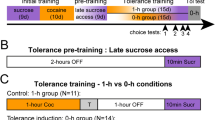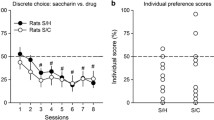Abstract
All drug discrimination procedures share in common the practice of providing for multiple choice opportunities per training session. This practice allows nondrug cues (presence or absence of reinforcement) to mediate choice behavior during that portion of the session following the initial choice. Investigators who have acknowledged this problem typically use only first-trial choice performance to evaluate discriminative control by the drug cue, and consider additional choice training following the delivery or nondelivery of the first reinforcer to be facilitatory in establishing drug-mediated discriminative control. In this experiment, rats were trained to discriminate 4.0 mg/kg morphine from saline in a novel procedure that employed a single choice trial per training session. Choice performance was characterized during discrimination acquisition and in subsequent stimulus generalization testing. The results indicated that when all reinforcers are made contingent on correct performance during a single choice trial, rapid and stable control of drug-mediated choice behavior, is observed. In addition, the results demonstrated that additional choice training following the delivery or nondelivery of the first reinforcer is not a necessary antecedent toward establishing drug-mediated discriminative control.
Access this article
We’re sorry, something doesn't seem to be working properly.
Please try refreshing the page. If that doesn't work, please contact support so we can address the problem.
Similar content being viewed by others
References
Appel JB, White FJ, Kuhn DM (1978) The use of drugs as discriminative stimuli in behavioral pharmacodynamics. In: Colpaert FC, Rosecrans JA (eds) Stimulus properties of drugs: Ten years of progress. Elsevier/North Holland Biomedical, Amsterdam, pp 7–29
Appel JB, White FJ, Holohean AM (1982) Analyzing mechanisms of hallucinogenic drug action with drug discrimination procedures. Neurosci Biobehav Rev 6:529–536
Barry H, Krimmer EC (1978) Pharmacology of discriminative drug stimuli. In: Ho BT, Richards DW III, Chute DL (eds) Drug discrimination and state-dependent learning. Academic, New York, pp 3–34
Brady KT, Balster RL, May EL (1982) Stereoisomers of N-allylnormetazocine: Phencyclidine-like behavioral effects in squirrel monkeys and rats. Science 215:178–180
Colpaert FC (1978a) Some properties of drugs as physiological signals: The FR procedure and signal detection theory. In: Colpaert FC, Rosecrans JA (eds) Stimulus properties of drugs: Ten years of progress. Elsevier/North Holland Biomedical, Amsterdam, pp 217–242
Colpaert FC (1978b) Theoretical review: Discriminative stimulus properties of narcotic analgesic drugs. Pharmacol Biochem Behav 9:863–887
Colpaert FC, Lal H, Niemegeers CJE, Janssen PAJ (1975) Investigations of drug-produced and subjectively experienced stimuli. I. The fentanyl cue, a tool to investigate subjectively experienced drug actions. Life Sci 16:705–716
Colpaert FC, Niemegeers CJE, Janssen PAJ (1980) Factors regulating drug cue sensitivity; Limits of discriminability and the role of a progressively decreasing training dose in fentanyl-saline discrimination. J Pharmacol Exp Ther 219:474–480
Goas JA, Boston JE (1978) Discriminative stimulus properties of clozapine and chlorpromazine. Pharmacol Biochem Behav 8:235–241
Goudie AJ (1977) Discriminative stimulus properties of fenfluramine in an operant task: An analysis of its cue function. Psychopharmacology 53:97–102
Herling S, Woods JH (1981) Mini-symposium: Discriminative stimulus effects of narcotics: Evidence for multiple receptor-mediated actions. Life Sci 28:1571–1584
Herling S, Coale EH, Hein DW, Winger G, Woods JH (1981) Similarity of the discriminative stimulus effects of ketamine, cyclazocine and dextrorphan in the pigeon. Psychopharmacology 73:286–291
Hirschorn ID (1977) Pentazocine, cyclazocine and nalorphine as discriminative stimuli. Psychopharmacology 54:289–294
Holtzman SG (1980) Phencyclidine-like discriminative effects of opioids in the rat. J Pharmacol Exp Ther 214:614–619
Holtzman SG (1982) Stimulus properties of opioids with mixed agonist and antagonist activity. Fed Proc 41:2328–2332
Jarbe TUC (1978) Discriminative effects of morphine in the pigeon. Pharmacol Biochem Behav 9:411–416
Jenkins HM (1965) Measurement of stimulus control during discriminative operant conditioning. Psychol Bull 64:365–376
Kelleher RT (1966) Chaining and conditioned reinforcement. In: Honig WK (ed) Operant behavior: Areas of research and application, Appleton-Century-Crofts, New York, pp 160–212
Krimmer EC, Barry H III (1980) Effects of dosage on discrimination of morphine from saline. Pharmacol Biochem Behav 13:313
Mackintosh NJ (1974) The psychology of animal learning. Academic, London, pp 580–582
McMillan DE, Cole-Fullenwider DA, Hardwick WC, Wenger GR (1982) Phencyclidine discrimination in the pigeon using colortracking under second-order schedules. J Exp Anal Behav 37:143–147
Overton DA (1974) Experimental methods for the study of state-dependent learning. Fed Proc 33:1800–1811
Overton DA (1982) Multiple drug training as a method for increasing the specificity of the drug discrimination procedure. J Pharmacol Exp Ther 221:166–172
Rosecrans JA, Chance WT, Spencer RM (1978) The discriminative stimulus properties of cyclazocine: Generalization studies involving nalorphine, morphine and LSD. Res Commun Chem Pathol Pharmacol 20:221–237
Schuster CR (1976) Behavioral methods for the study of drug interactions. Ann NY Acad Sci 281:64–73
Shannon HE (1982) Pharmacological analysis of the phencyclidinelike discriminative stimulus properties of narcotic derivatives in rats. J Pharmacol Exp Ther 222:146–151
Teal JJ, Holtzman SG (1980) Discriminative stimulus effects of cyclazocine in the rat. J Pharmacol Exp Ther 212:368–376
White JM, Holtzman SG (1983) Further characterization of the three-choice morphine, cyclazocine and saline discrimination paradigm: Opioids with agonist and antagonist properties. J Pharmacol Exp Ther 224:95–99
Author information
Authors and Affiliations
Rights and permissions
About this article
Cite this article
Tomie, A., Loukas, E., Stafford, I. et al. Drug discrimination training with a single choice trial per session. Psychopharmacology 86, 217–222 (1985). https://doi.org/10.1007/BF00431713
Received:
Accepted:
Issue Date:
DOI: https://doi.org/10.1007/BF00431713




